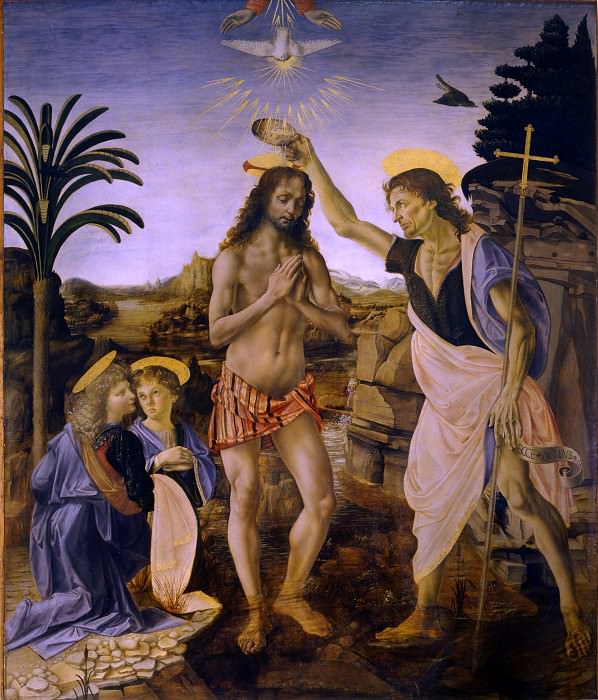Verrocchio, Leonardo da Vinci – Baptism of Christ Uffizi
Uffizi – Verrocchio, Leonardo da Vinci - Baptism of Christ
Edit attribution
Download full size: 2818×3300 px (1,7 Mb)
Back to album: Uffizi
The work was painted around 1472-1475. Andrea Verrocchio, specializing primarily in sculpture, carried out painting commissions with long interruptions. "He failed to complete the Baptism of Christ for a long time, so he commissioned one of his pupils to finish the work - so Leonardo da Vinci became Verrocchio’s collaborator. The angel and the two figures occupying the center were depicted by Andrea: in them one traces his characteristic dry manner, the wiriness and "plasticity" of the bodies.
Description of Andrea Verrocchio’s Baptism of Christ
The work was painted around 1472-1475. Andrea Verrocchio, specializing primarily in sculpture, carried out painting commissions with long interruptions. "He failed to complete the Baptism of Christ for a long time, so he commissioned one of his pupils to finish the work - so Leonardo da Vinci became Verrocchio’s collaborator.
The angel and the two figures occupying the center were depicted by Andrea: in them one traces his characteristic dry manner, the wiriness and "plasticity" of the bodies. Leonardo painted the second angel on the left, using oil paints rather than tempera like his mentor. Oil dries much longer and is laid down in a smooth layer, allowing you to transfer light and shade, a little blurred images.
As a consequence, and was born well-known Leonard technique. He depicted some of the background, based on his earlier sketches of the Arno Valley. Verrocchio was more than pleased and impressed with the result: the young pupil’s creation was so outstanding that it was used to sketch angels.
It should be noted that the work is different in color and variety of shades: this is very atypical for paintings of religious themes. The authors are putting elements of symbolism into the work - you can see this by looking at the background. One can feel the influence of medieval painting traditions.
The characters’ movements are constrained, as if they exist only in two dimensions. The faces lack individuality, suggesting that the figure is more an image than a person. The landscape has no perspective, more reminiscent of icon painting than painting. Against the background of all the other characters, the body of the angel on the left stands out for its naturalness and lightness.
Due to the fact that the painting was painted by two great artists with very different painting styles, the work looks unique and very different from similar paintings of the time.
Кому понравилось
Пожалуйста, подождите
На эту операцию может потребоваться несколько секунд.
Информация появится в новом окне,
если открытие новых окон не запрещено в настройках вашего браузера.
You need to login
Для работы с коллекциями – пожалуйста, войдите в аккаунт (open in new window).




















You cannot comment Why?